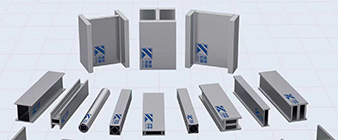Corrosion resistance:
2205 has excellent resistance to pitting, crevice and stress corrosion cracking, making it suitable for use in harsh corrosive environments.
The alloy’s high chromium (22%) and molybdenum (3%) content provides strong corrosion protection in a variety of media, including seawater, chlorides and various chemicals.
The dual-phase microstructure of balanced ferrite and austenite further enhances the corrosion resistance of 2205.
Mechanical Properties:
2205 has significantly higher tensile and yield strengths than standard austenitic stainless steels such as 304 or 316.
Typical tensile strengths range from 620 to 860 MPa and yield strengths from 450 to 650 MPa.
The unique dual-phase microstructure provides a good balance of strength and ductility, with elongations typically around 25-35%.
2205 also exhibits high toughness, making it suitable for applications where impact resistance is important.
Thermal and Low Temperature Performance:
2205 maintains its mechanical properties and corrosion resistance at both high and low temperatures.
It can be used in cryogenic applications, such as liquefied natural gas (LNG) facilities, and in high-temperature environments, such as petrochemical plants.
Weldability:
2205 is generally considered weldable, but welding parameters require careful control of welding parameters to maintain the required ferrite-austenite balance and prevent harmful phases.
Proper welding procedures and post-weld heat treatment are essential to ensure the required mechanical and corrosion properties of welded joints.
Cost-Effectiveness:
Compared to superduplex stainless steel, 2205 offers a more cost-effective solution while still delivering superior performance.
The combination of high strength, corrosion resistance and relatively low cost makes 2205 a popular choice for many industrial and structural applications.
-
 2024-9-25 1.4547 Super Stainless Steel for Structural Applications
2024-9-25 1.4547 Super Stainless Steel for Structural Applications -
 2024-9-16 UNS S31803 stainless steel Hollow Sections and steel profiles of innovative applications
2024-9-16 UNS S31803 stainless steel Hollow Sections and steel profiles of innovative applications -
 2024-9-20 What are the advantages of S690 steel in construction engineering compared with conventional steel?
2024-9-20 What are the advantages of S690 steel in construction engineering compared with conventional steel? -
 2024-9-19 UNS N08904 VS 1.4539 stainless steel performance
2024-9-19 UNS N08904 VS 1.4539 stainless steel performance -
 2024-9-16 UNS S32304 stainless steel structural performance
2024-9-16 UNS S32304 stainless steel structural performance -
 2024-9-21 Application of S690 steel in bridge engineering?
2024-9-21 Application of S690 steel in bridge engineering? -
 2024-9-25 Super Duplex Stainless Steel UNS S32760 / 1.4501
2024-9-25 Super Duplex Stainless Steel UNS S32760 / 1.4501



